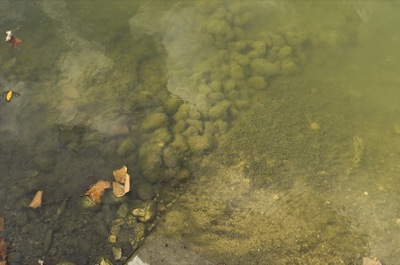Thursday, October 7th, 2010
EPA: Water clarity not gauge of success
By Nancy Allen

Photo by Mark Pummell/The Daily Standard
The water at a test site at Harmon's Landing was clearer after receiving alum on Sept. 23. Those interested in the pilot test say water clarity has returned to what it was prior to the treatment. The Ohio EPA said improved water clarity will not be the gauge of the study's success.
GRAND LAKE - The water in Grand Lake isn't clear and neither are the results - yet -of the recent alum pilot study.
An EPA official on Wednesday said it's too early to form any conclusions about the test and noted improved water clarity will not be the gauge of success.
Alum was added to sites at Harmon's Landing, the West Bank boat launch and a channel at Otterbein Retirement Community on Sept. 23 and 24. The state is trying to determine if alum (aluminum sulfate) can reduce the lake's toxic blue-green algae by taking away its food source. Alum binds phosphorous and causes it to drop to the lake's bottom.
"The goal is to bind the phosphorous and get it out of the water column and make it unavailable to the algae and that, in turn, should prevent future outbreaks," said Dina Pierce, Ohio EPA spokeswoman. "That won't be known until the results are put together and the patterns are analyzed."
The alum test will take 60 days. The Ohio EPA is now gathering data on levels of phosphorous, pH, dissolved oxygen levels and water clarity. Samples also are being taken from a control site to compare treated and untreated water. Curtains installed around each of the sites will be removed in November.
The data will be sent to Tetra Tech, the consulting firm hired by the state to design the alum study and analyze the results. The hope is that phosphorous levels will be reduced enough to decrease the toxic blue-green algae to a point that good, diatom algae can become dominant, a Tetra Tech official said.
Within a few hours after alum was applied in September, water clarity improved. At the Harmon's Landing site the clarity improved from a few inches to 41/2 feet in some areas, said Scott Fletcher of the Ohio Department of Natural Resources.
But as of Friday, the water clarity had returned to about what it was prior to adding the alum, said Lake Improvement Association (LIA) member Bill Ringo recently.
Pierce said improved clarity is not the gauge of success, though it would be a bonus. She noted many inland lakes in Ohio are murky, even ones that do not have extensive blue-green algae problems.
"The measure is going to be a phosphorous reduction which cannot be measured by looking at the water and seeing if it is clearer or not ... this takes a chemical analysis," she said. "The alum treatment, even if it is a success, is not going to produce a crystal clear lake," she added.
If alum is effective in reducing blue-green algae, the state will treat the entire lake in the spring at an estimated cost of $10 million, Fletcher said. The pilot project is being funded through a $250,000 Ohio EPA grant. Officials have said they "will leave no stone unturned" to find the money needed.
Fletcher noted a whole-lake treatment would be used as a short-term solution to reduce internal loading - phosphorous already in the lake.
During the temporary fix, the state plans to make changes in land management practices in the 98,000-acre Grand Lake watershed to reduce external loading - the amount of phosphorous running off land and into the lake. Most of the phosphorous comes from farmland, which comprises more than 80 percent of acreage in the watershed.
A second short-term solution being tested involves adding silica (sand) to the lake to feed the lake's good, diatom algae so it overtakes the blue-green algae. That test site is near the Celina Rotary lighthouse and began Aug. 31. This $25,000 pilot study is being funded by the Ohio Department of Agriculture.
Kaleigh Frazier, ODA spokeswoman, said a report on the silica study will be available in early November. No preliminary results are available, she said.
Massive toxic algae blooms led the state to place a no contact water advisory on the lake July 16. The advisory was downgraded on Aug. 26 to again allow boating after toxin levels dropped. They have continued to drop dramatically in recent weeks, but the lake still remains under a toxin advisory.



